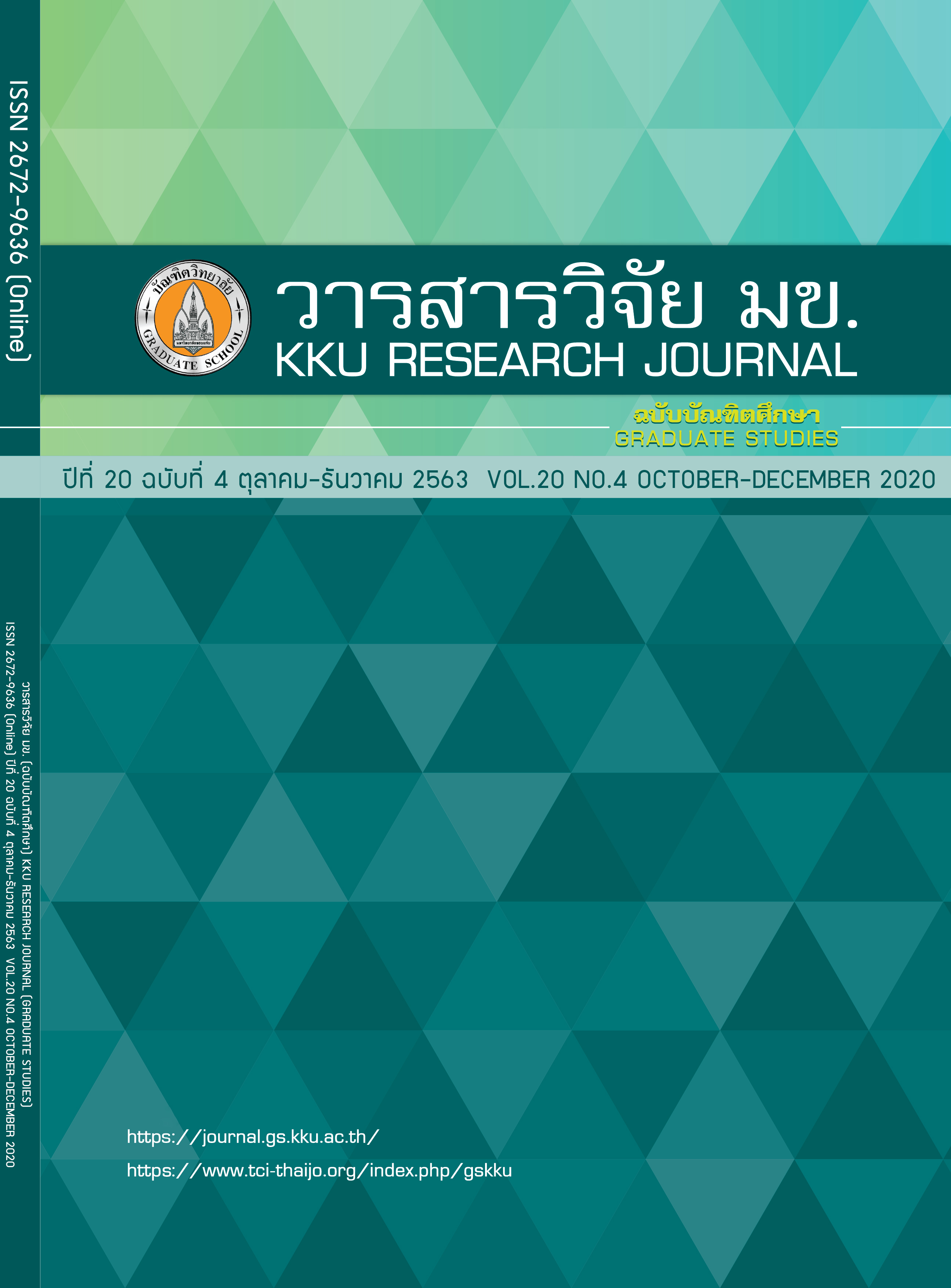Effect of Nickel Doped Titanium Dioxide Catalyst on Methanol Synthesis From Carbon Dioxide Via Photochemical Reaction Under Ultraviolet Irradiation
Keywords:
Transition metal, Photocatalytic reduction, Green house gas, Sol-gel, CarbondioxideAbstract
Photocatalytic reduction of carbon dioxide into methanol fuel has been investigated by using the Ni-doped TiO2 photocatalyst. The experiment was carried out under a 50 ml batch reactor in the liquid phase and UV irradiation. Ni/TiO2 photocatalysts were prepared by a sol-gel method. The Characterization of photocatalysts was analyzed by X-ray diffraction (XRD), X-ray photoelectron spectroscopy (XPS), UV-vis diffuse reflectance (UV-Dr), and scanning electron microscope (SEM). Moreover, the effect of reaction time and Ni loading on the methanol conversion were studied. It was found that the methanol concentration decreased with increasing reaction time due to the degradation of methanol. The Ni loading exhibited the higher methanol than undoped TiO2 because Ni could trap the electron during irradiation and reduce electron-hole pair recombination by the p-n junction of TiO2. However, the increased of Ni loading affected to methanol decreased due to the face that the surface reduction. The highest methanol production rate at 384 μmol gcat.-1 was obtained over 1% wt — Ni/TiO2 catalyst for 2 hours, which is 15 times higher methanol production than that over the P25 commercial catalyst. Therefore, 1% wt. Ni/TiO2 showed better potential and activity in reducing CO2 emission to the environment.
References
Zhao G, Zhou W, Sun Y, Wang X, Liu H, Meng X, et al. Efficient photocatalytic CO 2 reduction over Co(II) species modified CdS in aqueous solution. 2018 [cited 2018 Aug 20]; Available from: https://doi.org/10.1016/j.apcatb.2017.12.054
Huang Z, Xue K, Zhang Y, Cheng X, Dong P, Zhang X. TiO 2 hybrid material film with high CO 2 adsorption for CO 2 photoreduction. J Alloys Compd [Internet]. 2017;729:884–889. Available from: http://linkinghub.elsevier.com/retrieve/pii/S0925838817331821
Lashgari M, Soodi S, Zeinalkhani P. Photocatalytic back-conversion of CO2 into oxygenate fuels using an efficient ZnO/CuO/carbon nanotube solar-energy-material: Artificial photosynthesis. J CO2 Util [Internet]. 2017;18:89–97. Available from: http://dx.doi.org/10.1016/j.jcou.2017.01.017
Li Y, Wang W-N, Zhan Z, Woo M-H, Wu C-Y, Biswas P. Photocatalytic reduction of CO2 with H2O on mesoporous silica supported Cu/TiO2 catalysts. Appl Catal B Environ [Internet]. 2010 Oct 11 [cited 2019 Apr 21];100(1–2):386–392. Available from: https://www.sciencedirect.com/science/article/pii/S0926337310003681
Kavil YN, Shaban YA, Al Farawati RK, Orif MI, Zobidi M, Khan SUM. Photocatalytic conversion of CO 2 into methanol over Cu-C/TiO 2 nanoparticles under UV light and natural sunlight. J Photochem Photobiol A Chem [Internet]. 2017;347:244–253. Available from: http://linkinghub.elsevier.com/retrieve/pii/S1010603017301090
Kočí K, Obalová L, Matějová L, Plachá D, Lacný Z, Jirkovský J, et al. Effect of TiO2 particle size on the photocatalytic reduction of CO2. Appl Catal B Environ. 2009;89(3–4):494–502.
Xiong Z, Wang H, Xu N, Li H, Fang B, Zhao Y, et al. Photocatalytic reduction of CO2 on Pt2+–Pt0/TiO2 nanoparticles under UV/Vis light irradiation: A combination of Pt2+ doping and Pt nanoparticles deposition. Int J Hydrogen Energy [Internet]. 2015;40(32):10049–10062. Available from: http://linkinghub.elsevier.com/ retrieve/pii/S0360319915015608
Ola O, Maroto-valer MM. Applied Catalysis A : General Transition metal oxide based TiO 2 nanoparticles for visible light induced CO 2 photoreduction. "Applied Catal A, Gen [Internet]. 2015;502:114–121. Available from: http://dx.doi.org/10.1016/j.apcata.2015.06.007
Low J, Cheng B, Yu J. Surface modification and enhanced photocatalytic CO 2 reduction performance of TiO 2 : a review. Appl Surf Sci [Internet]. 2017;392:658–686. Available from: http://linkinghub.elsevier.com/retrieve/pii/S0169433216319626
Khan MR, Chuan TW, Yousuf A, Chowdhury MNK, Cheng CK. Schottky barrier and surface plasmonic resonance phenomena towards the photocatalytic reaction: Study of their mechanisms to enhance photocatalytic activity. Catal Sci Technol. 2015;5(5):2522–2531.
Billo T, Fu F, Raghunath P, Shown I, Chen W, Lien H, et al. Ni-Nanocluster Modified Black TiO 2 with Dual Active Sites for Selective Photocatalytic CO 2 Reduction. 2017;1702928:1–11.
Maria L, Colpini S, Gonc G, Barbian M, Kochepka M, Jose H. Journal of Environmental Chemical Engineering Photodiscoloration of textile reactive dyes on Ni / TiO 2 prepared by the impregnation method : Effect of calcination temperature. 2014;1–7.
Riaz N, Chong FK, Dutta BK, Man ZB, Khan MS, Nurlaela E. Photodegradation of Orange II under visible light using Cu–Ni/TiO2: Effect of calcination temperature. Chem Eng J [Internet]. 2012 Mar 15 [cited 2019 Apr 21];185–186:108–119. Available from: https://www.sciencedirect.com/science/article/pii/S1385894712000551
The International Centre for Diffraction Data - ICDD [Internet]. [cited 2019 Apr 21]. Available from: http://www.icdd.com/
Suwannaruang T, Kidkhunthod P, Chanlek N, Soontaranon S, Wantala K. PT SC. Appl Surf Sci [Internet]. 2019;#pagerange#. Available from: https://doi.org/10.1016/j.apsusc.2019.01.158
Science S, Imtituto DQ, Inorgdnica C, Received S. Xps Study of Phase Mobility. 1989;212:1113–1122.
Petrik IS, Krylova G V, Lutsenko L V, Smirnova NP, Oleksenko LP. XPS AND TPR STUDY OF SOL-GEL DERIVED M / TiO 2 POWDERS ( M = Co , Cu , Mn , Ni ). 2015;179–189.
Zhao C, Liu L, Zhang Q, Wang J, Li Y. Photocatalytic conversion of CO 2 and H 2 O to fuels by nanostructured Ce–TiO 2 /SBA-15 composites. Catal Sci Technol Catal Sci Technol. 2558;1(2):2558–2568.
Luna AL, Novoseltceva E, Louarn E, Beaunier P, Kowalska E, Ohtani B, et al. Synergetic effect of Ni and Au nanoparticles synthesized on titania particles for efficient photocatalytic hydrogen production. Appl Catal B Environ [Internet]. 2016;191:18–28. Available from: http://dx.doi.org/10.1016/j.apcatb.2016.03.008
Huang C, Guo R, Pan W, Tang J, Zhou W, Qin H. Eu-doped TiO 2 nanoparticles with enhanced activity for CO2 phpotcatalytic reduction. J CO2 Util [Internet]. 2018;26(May):487–495. Available from: https://doi.org/10.1016/j.jcou.2018.06.004
Zbudniewek K, Góralski J, Rynkowski J. Studies on TiO 2 / SiO 2 and Pd / TiO 2 / SiO 2 Catalysts in Photoreduction of CO 2 with H 2 O to Methanol 1. 2012;86(13):2057–2062.
Kočí K, Matějů K, Obalová L, Krejčíková S, Lacný Z, Plachá D, et al. Effect of silver doping on the TiO2 for photocatalytic reduction of CO2. Appl Catal B Environ [Internet]. 2010 Jun 7 [cited 2019 Apr 21];96(3–4): 239–344. Available from: https://www.sciencedirect.com/science/article/pii/S092633731000086X
Sharma A, Lee BK. Photocatalytic reduction of carbon dioxide to methanol using nickel-loaded TiO2 supported on activated carbon fiber. Catal Today. 2017;298(November 2016):158–167.



